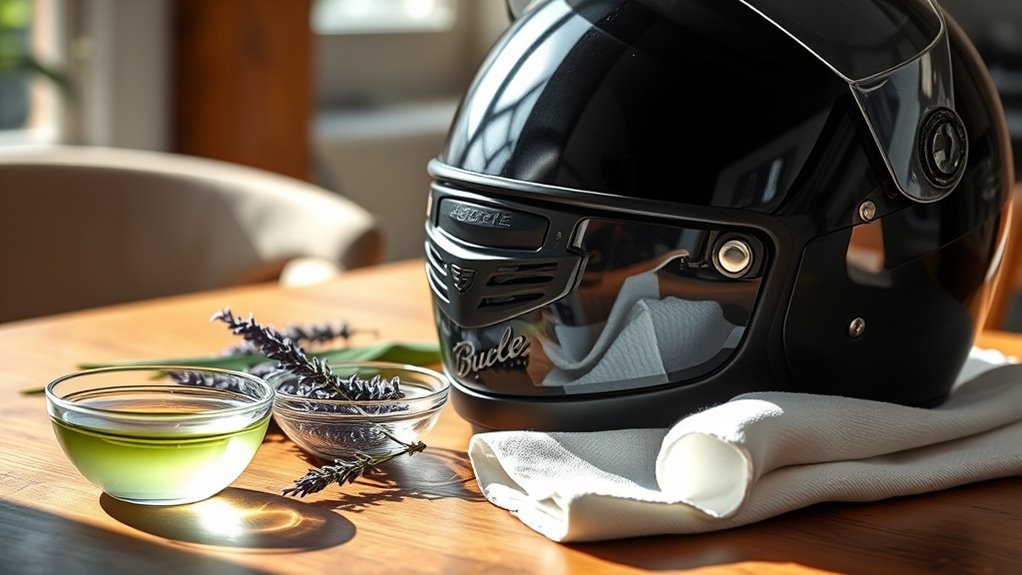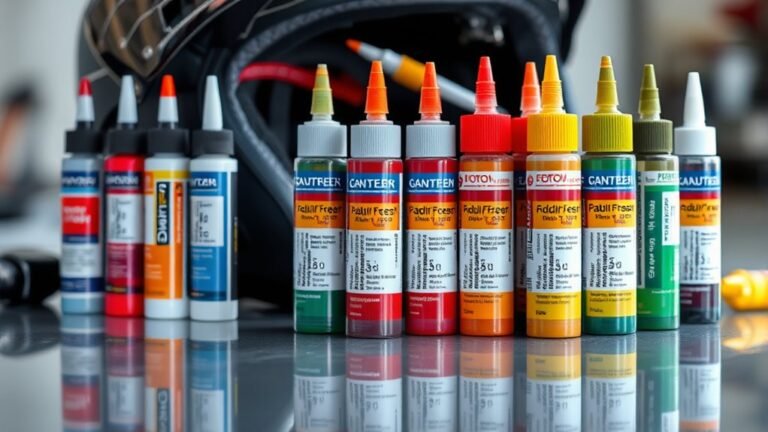How to Prevent Helmet Itch and Skin Irritation
To prevent helmet itch and skin irritation, choose a helmet made from breathable, lightweight materials like fiberglass or polycarbonate. Regularly clean your helmet to stop sweat and dirt buildup. Using moisture-wicking liners and applying natural moisturizers can help keep your scalp comfortable. Maintain good hygiene by storing your helmet properly and taking breaks to relieve pressure. Listening to your body for discomfort signals is crucial. Discover more effective strategies to enhance your outdoor experience.
Understanding Helmet Itch and Skin Irritation
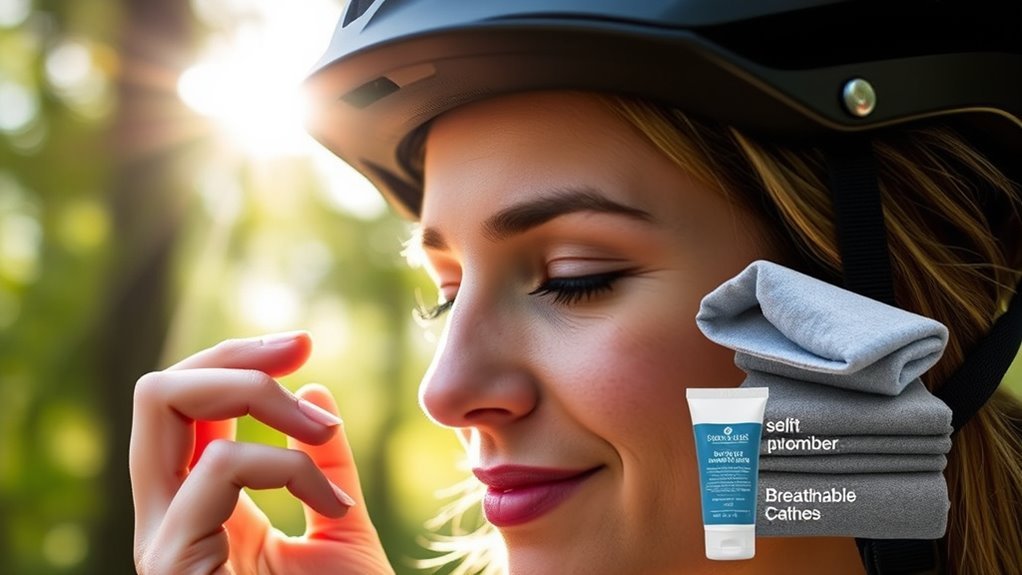
When you wear a helmet for extended periods, you might experience what’s commonly referred to as helmet itch, a form of skin irritation that can be both uncomfortable and distracting. The causes of irritation can include friction between the helmet lining and your skin, sweat accumulation, and allergens in the materials. Additionally, wearing a helmet that doesn’t fit properly can exacerbate these issues. To combat helmet itch, consider implementing prevention strategies such as regularly cleaning your helmet to remove sweat and skin cells, using moisture-wicking headgear, and ensuring a snug but comfortable fit. You can also apply barrier creams or lotions to your scalp to reduce irritation. Addressing these factors helps maintain your comfort and enhances your freedom while enjoying outdoor activities.
Choose the Right Helmet Material
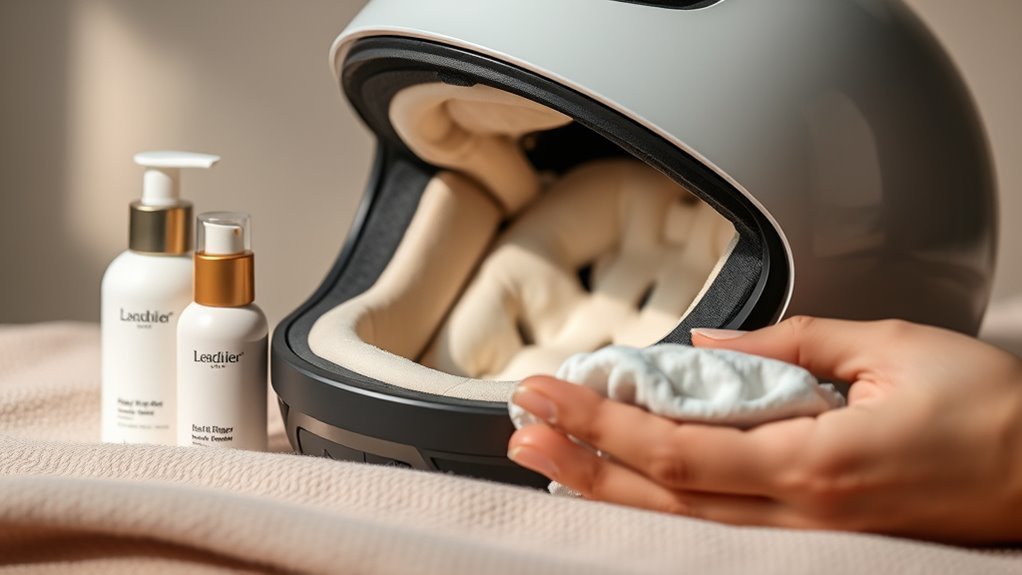
Choosing the right helmet material is crucial for minimizing discomfort and preventing helmet itch. Different helmet types utilize various materials, each offering unique benefits. For instance, fiberglass helmets are lightweight and provide excellent ventilation, reducing sweat accumulation. Polycarbonate helmets are durable and impact-resistant, guaranteeing protection without excessive weight. If comfort is your priority, consider helmets with moisture-wicking liners that can help alleviate skin irritation. Additionally, materials with antimicrobial properties can prevent the growth of bacteria, further reducing the risk of itchiness. When selecting a helmet, evaluate these material benefits carefully to maintain a balance between safety and comfort. Your choice can greatly enhance your riding experience while keeping skin irritation at bay.
Keep Your Helmet Clean
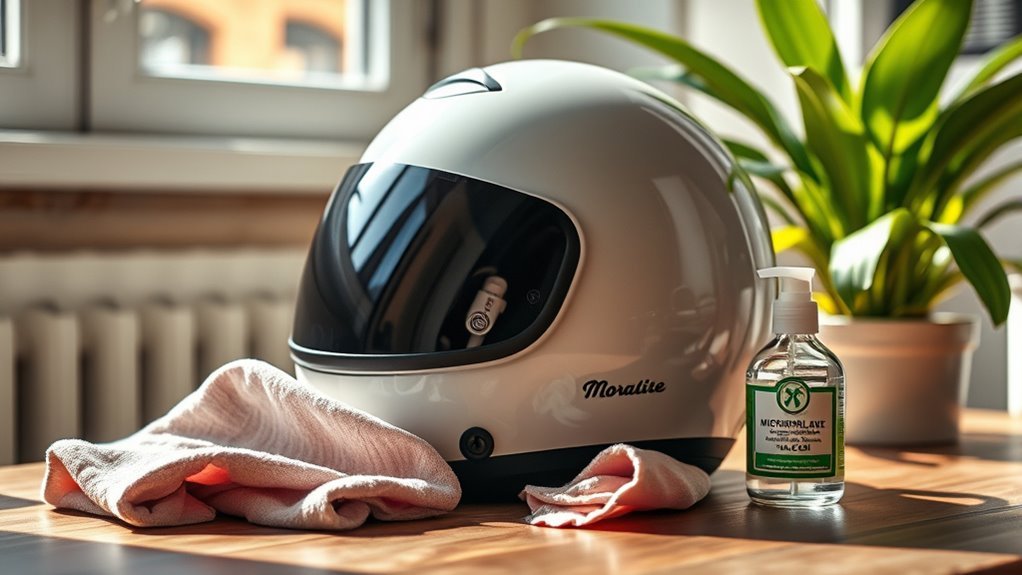
Maintaining a clean helmet is essential for preventing helmet itch and guaranteeing overall comfort during rides. Regular helmet cleaning not only removes sweat and dirt but also minimizes the risk of skin irritation. Incorporate a routine that includes wiping the interior with a damp cloth and using mild soap. Ascertain thorough drying before wearing it again.
Here’s a simple maintenance checklist to keep in mind:
| Task | Frequency | Notes |
|---|---|---|
| Wipe Interior | After every ride | Use a damp cloth |
| Wash Padding | Monthly | Remove padding if possible |
| Inspect for Damage | Weekly | Check for cracks or wear |
| Store Properly | Daily | Keep in a cool, dry place |
Consistent helmet maintenance can greatly enhance your riding experience.
Use Moisturizers and Scalp Treatments
To effectively combat helmet itch, selecting the right moisturizer is essential for maintaining scalp health. Incorporating targeted scalp treatment techniques can also alleviate dryness and irritation. Understanding these factors will enhance your comfort while wearing a helmet.
Choose the Right Moisturizer
When it comes to preventing helmet itch, selecting the right moisturizer can make a significant difference in maintaining scalp health. Opt for products that contain natural ingredients, as they’re less likely to irritate your skin. Look for a lightweight formula that absorbs quickly without leaving a greasy residue, allowing your scalp to breathe while providing necessary hydration. Ingredients like aloe vera, tea tree oil, and jojoba oil are excellent choices due to their soothing and nourishing properties. Applying moisturizer regularly can help create a barrier against friction and sweat, reducing irritation. Remember, consistency is key; make it part of your routine to keep your scalp comfortable and itch-free, enhancing your overall riding experience.
Scalp Treatment Techniques
While it may seem simple, using effective scalp treatment techniques is essential for preventing helmet itch. Start by incorporating scalp exfoliation techniques into your routine. Regular exfoliation removes dead skin cells, promoting healthier scalp conditions. You can use gentle scrubs or specialized exfoliating products designed for the scalp.
In addition, consider applying soothing scalp masks weekly. These masks can hydrate and calm irritation, providing relief from dryness and itchiness. Look for masks containing natural ingredients like aloe vera or tea tree oil for their soothing properties.
Finally, don’t forget to moisturize your scalp. A well-hydrated scalp is less prone to irritation, ensuring your comfort while wearing a helmet. Prioritize these techniques for a healthier scalp.
Wear a Moisture-Wicking Liner
Choosing a moisture-wicking liner can markedly reduce helmet itch by effectively managing sweat and moisture. These liners are specifically designed to minimize moisture retention, allowing for a more comfortable fit during prolonged wear. When sweat accumulates, it can lead to irritation, but moisture-wicking materials pull moisture away from your skin, keeping your scalp dry and comfortable. Additionally, a well-fitted liner enhances the overall comfort fit of your helmet, ensuring it sits correctly without causing pressure points. Look for liners made from breathable fabrics that promote airflow, which can further mitigate heat buildup. By incorporating a moisture-wicking liner, you not only enhance your riding experience but also protect your scalp from unnecessary irritation and discomfort.
Maintain Good Hygiene Practices
To effectively prevent helmet itch, maintaining good hygiene practices is crucial. Start with daily cleaning of the helmet’s interior. Use a mild soap and water solution to remove sweat and oils, which can foster bacterial growth. Ascertain you wipe down the liner and padding thoroughly, allowing the materials to dry completely.
Proper helmet storage is equally important. Store your helmet in a cool, dry place, away from direct sunlight, which can degrade materials over time. Avoid leaving it in damp or humid environments, as this can lead to mold and mildew. By prioritizing these hygiene practices, you not only enhance your comfort but also extend the life of your helmet, ultimately supporting your freedom to ride without irritation.
Take Regular Breaks
Taking regular breaks during prolonged helmet use can greatly reduce the risk of helmet itch. It’s essential to establish a consistent break frequency, allowing your skin to breathe and recover from the pressure and moisture buildup caused by the helmet. Aim for short breaks every hour, but adjust based on your comfort level and activity. During these pauses, remove the helmet to give your scalp and skin necessary recovery time. This practice not only alleviates irritation but also enhances overall comfort, allowing you to enjoy your activities freely. Remember, the key is to listen to your body; if you start feeling discomfort, don’t hesitate to take a break. Regular intervals can make a significant difference in skin health and helmet wearing experience.
Consult a Dermatologist if Needed
If you continue to experience persistent helmet itch despite taking regular breaks, consulting a dermatologist may be the best course of action. A professional can help identify any underlying skin conditions and provide tailored recommendations. Here are a few reasons to seek their expertise:
- Diagnosis: They can accurately diagnose potential skin conditions contributing to your discomfort.
- Treatment Options: Dermatologists offer various treatments, from medicated shampoos to topical creams.
- Professional Advice: You’ll receive personalized advice on managing irritation while wearing a helmet.
- Prevention Strategies: They can suggest methods to prevent future flare-ups.
Don’t hesitate to seek professional help—your skin deserves the freedom to feel comfortable and healthy.
Frequently Asked Questions
Can Wearing a Helmet Cause Hair Loss or Thinning?
Yes, wearing a helmet can contribute to hair loss or thinning due to helmet pressure and its effects on scalp health. For instance, a study showed that athletes who frequently wore tight-fitting helmets experienced increased hair shedding. The pressure can restrict blood flow to hair follicles, leading to weakened growth. To mitigate these risks, make certain your helmet fits properly and allows for some airflow, promoting healthier scalp conditions and preserving your hair.
Are There Specific Brands Known for Preventing Helmet Itch?
Some specific brands, like Giro and Bell, offer helmets with moisture-wicking liners designed to reduce irritation. You might also consider using anti-itch sprays before wearing your helmet to further alleviate discomfort. These products can help keep your scalp dry and minimize friction. Choosing helmets with breathable materials can enhance your comfort, allowing for more enjoyable rides without the annoyance of itchiness. Always prioritize your skin’s health while enjoying your freedom on the road.
How Often Should I Replace My Helmet to Avoid Irritation?
You should replace your helmet every three to five years, depending on usage and conditions. This helmet lifespan is essential for maintaining safety and comfort. Regular wear can lead to degradation of materials, which may contribute to irritation. If you notice any signs of wear, such as cracks or fading, consider replacing it sooner. Staying proactive about replacement frequency will help guarantee a comfortable fit and reduce the risk of skin issues.
Is Helmet Itch More Common in Certain Weather Conditions?
Yes, helmet itch can be more common in specific weather conditions. High humidity levels can lead to excess sweat and moisture, promoting irritation. Conversely, temperature fluctuations can cause your skin to dry out, leading to itchiness. If you’re riding in varied climates, consider breathable helmets or moisture-wicking liners to mitigate these effects. Staying aware of the weather can help you choose the right gear and reduce the likelihood of discomfort.
Can I Use Regular Shampoo for Helmet-Related Scalp Issues?
You can use regular shampoo for helmet-related scalp issues, but it’s wise to choose one designed for scalp care. Look for gentle, sulfate-free options that won’t strip oils or irritate your skin. While some shampoos target specific conditions, like dandruff or dryness, others might not address the unique challenges of frequent helmet wear. Experimenting with different shampoo types can help you find what soothes your scalp and keeps it healthy.
